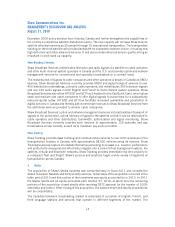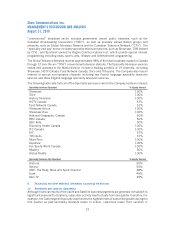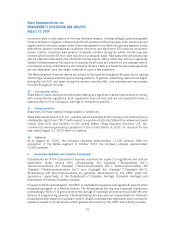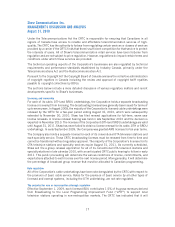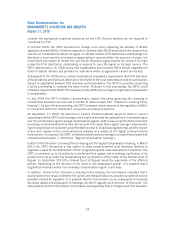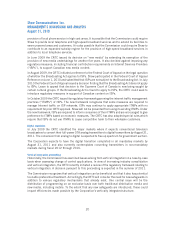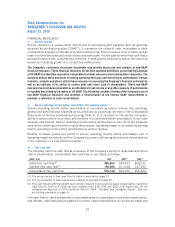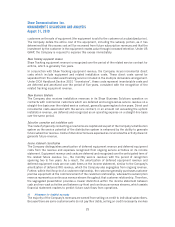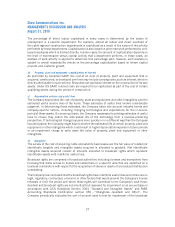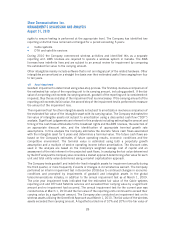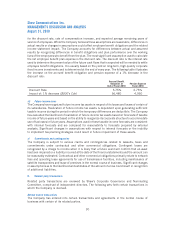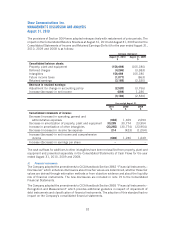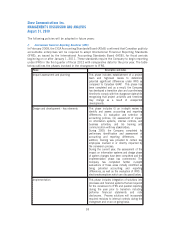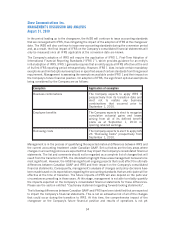Shaw 2010 Annual Report Download - page 28
Download and view the complete annual report
Please find page 28 of the 2010 Shaw annual report below. You can navigate through the pages in the report by either clicking on the pages listed below, or by using the keyword search tool below to find specific information within the annual report.Statements for additional information on accounting policies. The following section discusses key
estimates and assumptions that management has made under GAAP and how they affect the
amounts reported in the Consolidated Financial Statements and notes. It also describes significant
accounting policies where alternatives exist. In addition, within the critical accounting policies and
estimates, Canadian-US GAAP differences are identified where they exist. Refer to Note 22 to the
Consolidated Financial Statements for a complete reconciliation of Canadian-US GAAP
differences. Following is a discussion of the Company’s critical accounting policies:
i) Revenue and expense recognition
Revenue is considered earned as services are performed, provided that at the time of performance,
ultimate collection is reasonably assured. Such performance is regarded as having been achieved
when reasonable assurance exists regarding the measurement of the consideration that will be
derived from rendering the service. Revenue from cable, Internet, Digital Phone and DTH customers
includes subscriber service revenue when earned. The revenue is considered earned as the period of
service relating to the customer billing elapses.
The Company has multiple deliverable arrangements comprised of upfront fees (subscriber
connection fee revenue and/or customer premise equipment revenue) and related subscription
revenue. The Company determined that the upfront fees charged to customers do not constitute
separate units of accounting; therefore, these revenue streams are assessed as an integrated
package.
Subscriber connection fee revenue
Connection fees have no stand alone value to the customer separate and independent of the
Company providing additional subscription services, therefore the connection fee revenue must be
deferred and recognized systematically over the periods that the subscription services are earned.
There is no specified term for which the customer will receive the related subscription service,
therefore the Company has considered its customer churn rate and other factors, such as
competition from new entrants, to determine the deferral period of two years. Under US GAAP,
connection revenues are recognized immediately to the extent of related costs, with any excess
deferred and amortized.
Customer premise equipment revenue
Customer premise equipment available for sale, which generally includes DCT and DTH equipment,
has no stand alone value to the customer separate and independent of the Company providing
additional subscription services. Therefore the equipment revenue must be deferred and
recognized systematically over the periods that the subscription services are earned. As the
equipment sales and the related subscription revenue are considered one transaction, recognition
of the equipment revenue commences once the subscriber service is activated. There is no
specified term for which the customer will receive the related subscription service, therefore
the Company has considered various factors including customer churn, competition from new
entrants, and technology changes to determine the deferral period of two years.
In conjunction with equipment revenue, the Company also incurs incremental direct costs which
include equipment and related installation costs. These direct costs cannot be separated from the
undelivered subscription service included in the multiple deliverable arrangement. Under CICA
Handbook Section 3031 “Inventories”, these costs represent inventoriable costs and are deferred
and amortized over the period of two years, consistent with the recognition of the related equipment
revenue. The equipment and installation costs generally exceed the amounts received from
24
Shaw Communications Inc.
MANAGEMENT’S DISCUSSION AND ANALYSIS
August 31, 2010


